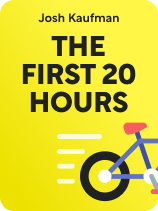

This article is an excerpt from the Shortform book guide to "The First 20 Hours" by Josh Kaufman. Shortform has the world's best summaries and analyses of books you should be reading.
Like this article? Sign up for a free trial here.
Would you like to learn a new skill but think you don’t have the time? What would you learn if you could gain proficiency in just 20 hours?
It can be hard to find the time, energy, and motivation to learn something new. Fortunately, in the international bestseller The First 20 Hours: How to Learn Anything Fast, Josh Kaufman provides a simple and effective method for learning almost any skill in just 20 hours.
Continue reading for an overview of this encouraging and instructive book.
Overview of The First 20 Hours
Has there been a skill you’ve been wanting to learn, but you’ve been putting it off for years? Whether you want to learn how to cook, speak a foreign language, or practice a martial art, by following Kaufman’s rapid skill acquisition process laid out in The First 20 Hours: How to Learn Anything Fast, you’ll pick up and enjoy your new skills as fast as humanly possible.
Kaufman is an expert in business and skill acquisition who’s written two other bestselling books: The Personal MBA and How to Fight a Hydra. He perfected the techniques he focuses on in this book—and proved their effectiveness—by learning six unrelated skills (yoga, programming, touch typing, the board game Go, ukulele, and windsurfing) in approximately 20 hours each.
We’ll first discuss the common misconceptions that hold us back from learning new skills and the science behind skill acquisition. Then, we’ll explore Kaufman’s step-by-step process for mastering the basics of any new skill with only 20 hours of practice, covering how to choose and research a skill, break it down into manageable subskills, and conduct effective practice.
The Myth of the 10,000 Hour Rule
Learning a new skill requires time and effort, but Kaufman argues that it’s not as hard as people often think: You can achieve a decent level of proficiency in most skills with only 20 hours of practice. He attributes the misconception that learning new things is too hard and too time-consuming in part to the 10,000 hour rule, an idea first popularized by Malcolm Gladwell in Outliers. According to Gladwell, becoming an expert in any skill requires at least 10,000 hours of deliberate practice.
However, Kaufman points out a crucial factor about skill acquisition that’s often lost in translation: There’s a difference between learning a skill and mastering it. The 10,000 hour rule only applies to attaining an expert-level performance in a skill, which isn’t the goal for most learners. Most of us want to learn a new skill for personal enjoyment and satisfaction, not to become world-class experts.
Kaufman writes that, if you just learn the essential components of a skill, you’ll boost your performance significantly. Only after reaching a certain threshold does it become harder and more time-consuming to improve, and only then does the 10,000 hour rule come into play.
The Science Behind Skill Acquisition
According to neuroscience research, you can improve any skill through practice because your brain is designed to learn and grow. Kaufman explains that your brain physically reorganizes itself in response to what you do, see, and experience. Whether you’re driving a car or drawing realistic portraits, when you learn a new skill, your brain creates new neural connections and pathways that help you perform it. The more you practice the skill, the stronger and more efficient these connections grow, allowing you to perform the skill with more ease and proficiency.
The Three Stages of Learning a Skill
Kaufman writes that there are three stages you progress through when learning a new skill.
1. Cognitive: You start off having to think hard about the skill—you’re trying to figure out how everything works and what you need to do. For instance, when you start learning to drive, you have to learn the rules of the road and how to operate the car.
2. Associative: With practice, you start noticing patterns and trying out different approaches, but you still have to think about what you’re doing. For example, when driving, you get better at adjusting your speed and predicting how much distance you need before merging, but you still need to consciously consider your actions as you go.
3. Autonomous: You can perform the skill without needing to think very hard about what you’re doing—you do it automatically. For example, as you become a more experienced driver, you don’t have to regularly remind yourself of how to operate the car and can go from one location to the next almost effortlessly.
How to Learn a New Skill in 20 Hours
While there’s no way to skip straight to the last stage of the skill acquisition process, you can speed up the process. You can do this by researching the skill enough to practice intelligently, breaking the skill down into its essential components, and then putting in 20 hours of focused practice time. Kaufman explains that the rate at which you learn a new skill depends on two factors: 1) How much time you devote to concentrated practice and 2) How intelligently you practice. To master the basics of a new skill in 20 hours, you need to optimize both of these factors. Kaufman’s process helps you do this—let’s look at it in more detail.
Step 1: Choose Your Skill
First, decide what skill you want to learn. Kaufman suggests you choose the skill you’re most excited about. The more interest you have in a skill, the more motivated and focused you’ll be and the faster you’ll improve.
Kaufman advises against trying to learn multiple new skills at the same time. Acquiring skills requires focus and concentration, and switching between different skills distracts you and slows down your progress. Concentrating your time and energy on one skill allows you to improve as fast as possible.
Once you’ve chosen the skill you want to acquire, set a goal for how proficient you want to become. To do this, Kaufman suggests you ask yourself why you want to learn the skill in the first place. Be specific and describe what you hope to accomplish with the skill so you can focus on practicing the aspects of it that are most relevant to your goal. For example, if you want to learn how to bake so you can make homemade cookies to share with friends and family, your goal could be to successfully bake three types of cookies from scratch.
Kaufman suggests you avoid aiming too high when deciding your goal. Ideally, the goal should be just out of reach. He explains that the more relaxed your goal is, the more quickly you can reach it and acquire the skill. Hitting your goal doesn’t have to signal the end of your skill-building—you can continue to practice and progress more if you’re still interested.
Step 2: Research and Prepare
Next, Kaufman suggests you conduct research to learn about the skill and prepare what you need to practice it. Acquiring knowledge and information about the skill beforehand allows you to practice smarter and avoid wasting time and energy on ineffective techniques.
Research just enough that you’ll be able to recognize and fix mistakes when practicing. Kaufman stresses that research and learning aren’t the same as practicing, so don’t spend too long on this step, as you’ll acquire a skill more quickly by practicing it than studying it endlessly.
Kaufman provides some suggestions for researching your skill:
Find Reference Materials
First, gather at least three resources (articles, books, and videos) that discuss the skill and quickly scan through them to find out what you need to know to practice. Look for approaches, techniques, and materials that the different resources agree on. For example, multiple art sources might recommend you learn form by drawing figures like spheres, cubes, and cylinders.
As you research your skill, you’ll likely encounter terms or concepts that are unfamiliar to you. Kaufman assures that confusion is not only normal at this point but encouraged. The more confused you are, the more motivated you’ll be to learn and the faster you’ll progress.
Look for Mental Models
To make the most of the information you find during your research, Kaufman recommends you look for mental models. These are concepts you learn that help you understand how something works. For instance, in creative storytelling, the Hero’s Journey (which describes a common 12-stage story structure) is a mental model for understanding how to structure a plot.
To remember the mental models you come across, use metaphors or analogies to connect them with things you already know and understand. For example, you can think of books or films that follow the Hero’s Journey structure. Drawing on these connections helps you to apply new knowledge more easily when you’re putting the skill to practice.
Consult Experts
Another way Kaufman suggests you research your skill is to ask experts for advice. Experts can clear up misconceptions you have about learning the skill and help you set realistic expectations for yourself. They may also have tips that can help you avoid wasting time, money, and energy on unnecessary supplies or ineffective techniques.
Gather Necessary Materials
In addition to learning about your skill, you’ll also need to gather the right tools and equipment to practice the skill. Based on your research, identify everything you’ll need and make sure you can acquire it—whether it’s a piece of equipment, software, or facility. This way, you won’t disrupt your practice by suddenly discovering that you’re missing a vital component.
Step 3: Identify Essential Subskills
Once you’ve completed your research, the next step is to separate the skill into subskills and focus on learning the most essential ones. Kaufman explains that most skills are composed of a set of smaller skills. These subskills should include everything you need to attain your proficiency goal (and you’ll likely have found some important ones during your research). For example, if you want to learn to skateboard for commuting purposes, you’ll need to learn several subskills, such as how to balance, push, and turn your board.
To make sure you’ve identified all crucial subskills, Kaufman suggests you think of the worst-case scenario that can occur when you’re practicing the skill. Think about what’s risky or what outcomes you want to avoid. For example, when you’re skateboarding, there’s a danger you’ll fall or crash into obstacles. This clues us in to some other vital subskills: How to brake with your foot and how to fall properly.
Step 4: Overcome Learning Obstacles
Before you start practicing a new skill, Kaufman recommends that you first think ahead and prepare for potential obstacles that may affect the quality of your practice.
Let’s look at a few common obstacles and how to avoid them.
Obstacle 1: Psychological Barriers
According to Kaufman, the biggest obstacle to learning new skills is emotion, not intellectual or physical capabilities. Learning a new skill is uncomfortable because it requires you to struggle and feel inadequate at first. You start off with many doubts and frustrations when all you want is for the skill to feel easy and fun. To overcome this barrier, focus on competence, not mastery. If you immediately want to be outstanding at something, you’ll get frustrated and discouraged.
Obstacle 2: Too Much Effort to Start Practicing
Another common obstacle to learning a skill is mustering the will to start practicing. Kaufman writes that your willpower is limited, and the more effort it takes to start practicing, the more likely you are to procrastinate or avoid doing it altogether. Because of this, he recommends you make it as easy and convenient as possible to start practicing your skill. For example, if your skill involves a lot of equipment that takes time to set up, you might clear out a dedicated space for it so you don’t have to set it up and take it down every time.
Obstacle 3: Distractions
External distractions, like noisy roommates or phone notifications, can also get in the way of you practicing your skill. To avoid these, Kaufman suggests you preemptively clear your surroundings of distractions in preparation for your practice. For example, you might practice before others are awake or clear away electronics from your desk.
Step 5: Practice Your Skill
Once you’ve made your preparations, it’s time to start practicing. To get good at any skill, you must practice it in a real-life context, not merely read about it or watch others do it. Because it’s easy to get frustrated and give up on a skill at the beginning, Kaufman recommends you commit to doing at least 20 hours of deliberate practice.
Deliberate practice is when you actively work on improving your skill instead of just passively doing things related to the skill, and Kaufman argues that it’s crucial for improvement. When he was learning to type with a different keyboard layout, for example, he found that his typing speed increased when he deliberately worked to improve his technique in focused sessions. However, when he went for a period of time without this deliberate practice, and instead just used his new keyboard for everyday tasks like writing emails, his typing speed didn’t increase.
Kaufman provides some tips for practicing your skill more effectively:
Tip #1: Break up your practice. Kaufman suggests you spend at least 90 minutes a day practicing your skill. But because practicing for a long time can be frustrating and difficult (especially when you’re starting out), he recommends you split your practice time into 20-minute chunks throughout the day. This allows you to remain focused while also getting in enough practice time.
Tip #2: Focus on quantity over quality. It’s more important to practice a skill regularly than to practice it perfectly. Instead of aiming to perform your skill as well as possible, focus on doing it “well enough” and as often as you can within a short period of time. This helps you learn quickly, as you get more chances to perform the skill and learn from your mistakes.
Tip #3: Use practice methods that give you immediate feedback. Ideally, you should practice in a way that lets you know immediately whether you did something right or wrong. Immediate feedback makes it easier for you to recognize with more accuracy what went wrong and to adjust your strategy. To get immediate feedback, you can use tools such as online tests, find coaches and mentors, or videotape yourself practicing.
Tip #4: Practice motor skills before sleep. Kaufman cites research showing that sleeping within four hours of practicing a motor skill helps your brain process and store the movements you learned, making the skill easier to execute the next time you practice.
Tip #5: Space out your studies. If the skill you’re learning requires memorizing information (for example, music notes and chords), Kaufman suggests you review the information at different time intervals—a technique called “spaced repetition.” This technique works because you need to revisit newer concepts more frequently than concepts you’re more familiar with to make them stick in your brain.
Tip #6: Create checklists and processes. Kaufman suggests you make the routine elements of your skill more effortless by creating checklists. For example, you could make a list of all the materials you’ll need for drawing that you can consult before you start. He also recommends creating processes for your practice so that your performance is consistent. For example, your process for drawing a landscape might be to find references, then sketch, then decide on the lighting, and then add colors.
Tip #7: Experiment. During your practice, try out various strategies and techniques that you’ve gathered during your research and brainstorm new ideas. Experimenting with techniques accelerates your learning by helping you find better ways to practice.

———End of Preview———
Like what you just read? Read the rest of the world's best book summary and analysis of Josh Kaufman's "The First 20 Hours" at Shortform.
Here's what you'll find in our full The First 20 Hours summary:
- A simple and effective method for learning almost any skill in 20 hours
- The misconceptions that hold us back from learning new skills
- Actionable tips to help you optimize your skill-building experience






